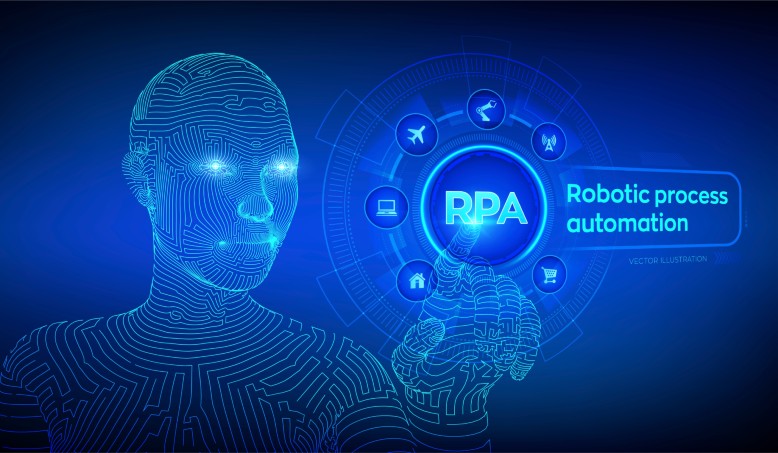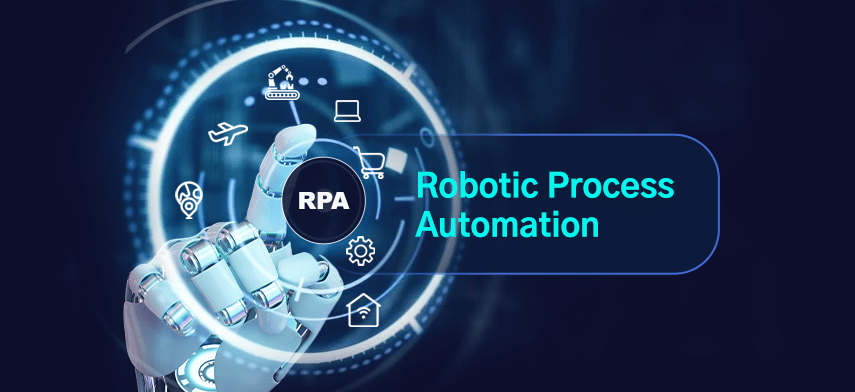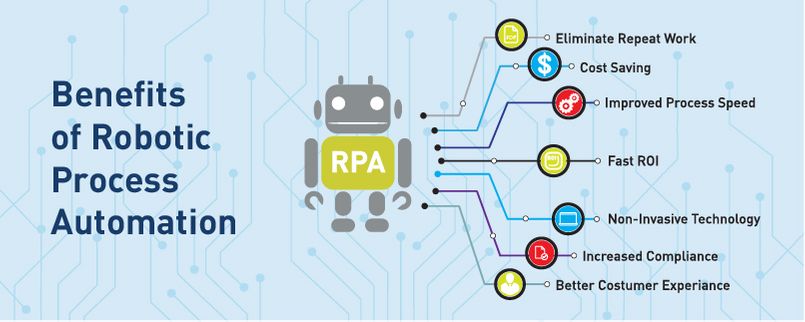Robotic Process Automation (RPA) refers to the definition of an employee’s tasks to robots and the complete fulfillment of all these tasks. Thanks to this new technology, robots can issue invoices, check emails, control the system and perform tasks automatically as desired.
Robotic Process Automation can be integrated into the IT infrastructure of any company in a short time as it does not require infrastructure changes. In addition, it is a great advantage that it does not require any system renewal. RPA is highly effective in increasing operational efficiency and performs its functions over the existing infrastructure of companies while also making it possible to control costs easily.

RPA and Examples
Robotic Process Automation enables employees to complete the service easily with minimum effort. For example, it monitors the inventories in the warehouse and sends the necessary warnings, ensuring that the resources are used in an optimized way. Employees can learn all the data from a single panel and follow the developments here. In this way, the reports prepared automatically can be examined.
The use of RPA to manage customer relationships allows tools to be managed automatically, thus accelerating the process. Data entries can be entered individually by RPA without error. Instead of using multiple tools at the same time, customer representatives can quickly handle the necessary transactions with only RPA. In this way, not only does customer satisfaction increase but also employee productivity boosts.

The Benefits of RPA
Robotic Process Automation provides many benefits. Main benefits of RPA are listed below.
- Provides cost savings
- Since it can be integrated directly into the working system without any problems, there is no need for an extra process and expense.
- The benefit can be observed in a short time.
- Errors are significantly reduced.
- Adapts to all kinds of computer technology
- The quality of the services offered by the company increases
- It is suitable for all businesses, big or small.
- Companies get added value.
- Increases the efficiency of the business process
- Increases customer satisfaction
- Significantly reduces operating costs.
- Provides profit in transaction time and speed
- Makes it possible to evaluate the process by considering it from every angle
- Provides fast scalability in case of an increase in demand

The Difference Between RPA and Automation
- Robotic Process Automation completes repetitive actions via structured digital data inputs. Automation configures unstructured data sources such as invoices or emails. In simple terms, RPA takes the robot from the human, and automation places the human in the robot.
- RPA has been used for over 20 years. While it has many advantages, it can have problems with scaling and can break if the process changes. Automation, on the other hand, is more flexible in adaptability.
- RPA can be integrated into any infrastructure. Therefore, returns can be observed in a short time. On the other hand, automation takes time to learn human behavior.
- RPA completes average-difficulty tasks more accurately and carefully through software robots. However, when it comes to complex data, it can be complicated and human intervention may be required. This is where automation gets involved.
- Robotic Process Automation primarily focuses on completing the manual activities of processes—ideal for reducing routine manual processing and increasing process efficiency. When used for these purposes, high efficiency is obtained from RPA. However, if critical decisions have to be made, problems may arise in complex processes. Automation is more effective at providing predictive analytical information.
Is RPA AI?
Robotic Process Automation and artificial intelligence are not the same things, and there are differences between them. RPA is a software robot programmed to mimic human actions. On the other hand, artificial intelligence re-simulates human intelligence using machines.
Artificial intelligence can spontaneously generate analytics, machine learning, and hypotheses even if not specifically defined. RPA, on the contrary, simply imitates human actions as it is told.
How RPA Uses In Business
Robotic Process Automation can operate effectively in many units in the company structure.
Human Resources
RPA can take the necessary steps for the human resources unit, that is, those who will start or leave the job, give the additional benefits offered to the employees, produce payroll, evaluate the performance of the employees and ensure that the employee is reported in compliance with the regulation.
Production Chain
RPA can perform operations such as shipping management, stock management, shipment order, invoice and contract management, supply and demand management, goods issue, and return acceptance in the production chain.
Finance and Accounting
RPA can control the purchasing process, manage orders, calculate monthly and annual closings, provide payment order flow, generate invoices and process them into the system.
Sales and Marketing
RPA can do social media scans & research about the market, complete transactions with customer information, communicate regularly with existing customers, follow up on what needs to be done for new customers and generate offers.
IT
It audits RPA licensed software, provides new user acceptance, renews & generates passwords, regularly inspects the system and manages applications & servers.
RPA Tools
Robotic Process Automation tools are preferred for configuring task automation. Their use is widespread and indispensable for automating back-office processes. There are many RPA tools available today. Choosing the right one for you and your company can be difficult.
You can make the right decision by sifting through the 20 tools selected among the popular ones. The RPA tools listed below include both paid (commercial) and free (open source) software.
- Autom Mate
- Keysight’s Eggplant
- Blue Prism
- Uipath
- Automation Anywhere
- Pega
- JAMS (14-day free trial)
- Power Automate (90-day free trial)
- ZAPTEST (request a demo & free trial)
- Kofax (90-day free trial)
- HelpSystems (30-day free trial)
Features of RPA tools are:
- Seamless Test+RPA Software Automation
- Functional and Performance Test Automation
- DevOps (Mock-ups) Automation
- Auto-Documentation
- RPA (Robotic Process Automation)
- API Testing
- Cross-Platform (Parallel) Execution
By finding the ideal Robotic Process Automation tools in line with the services provided by the company, requests & needs, you can have many advantages offered, increase your efficiency and significantly reduce costs.

 Benefits of Robotic Process Automation
Benefits of Robotic Process Automation